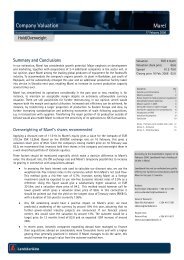Ársskýrsla Landsbankans - Landsbankinn
Ársskýrsla Landsbankans - Landsbankinn
Ársskýrsla Landsbankans - Landsbankinn
You also want an ePaper? Increase the reach of your titles
YUMPU automatically turns print PDFs into web optimized ePapers that Google loves.
Notes to the Consolidated Financial Statements<br />
3. Significant accounting policies (continued)<br />
Interest income and expense<br />
The interest income and expense presented in the income statement include:<br />
• Interest on financial assets and liabilities measured at amortised cost, calculated on an effective interest rate basis;<br />
• Interest on unpaid capital contribution, calculated on an accrual basis;<br />
• Interest on provisional liabilities, calculated on an accrual basis.<br />
Interest income and expense on financial assets and liabilities measured at amortised cost are recognised in the income statement using the effective<br />
interest method. The effective interest rate is the rate that exactly discounts the estimated future cash payments and receipts through the expected<br />
life of the financial asset or liability (or, where appropriate, a shorter period) to the carrying amount of the financial asset or liability. When<br />
calculating the effective interest rate, the Group estimates future cash flows considering all contractual terms of the financial instrument and it does<br />
not consider any future credit losses. The calculation of the effective interest rate includes all fees and points paid or received that are an integral<br />
part of the effective interest rate. Transaction costs include incremental costs that are directly attributable to the acquisition or issue of a financial<br />
asset or liability.<br />
Net impairment loss on loans and advances<br />
Impairment charges relating to loans and advances to financial institutions and customers are presented in the consolidated income statement under<br />
the item "Net impairment loss on loans and advances". After impairment has been recognised, interest income is recognised at the rate of interest<br />
used for discounting future cash flows when measuring impairment losses.<br />
Fee and commission income and expense<br />
Fees and commissions are generally recognised on an accrual basis as the related services are performed. Arrangement fees are generally deferred<br />
together with related direct costs and recognised as an adjustment to the effective interest rate on the loan. Commissions and fees for participation<br />
in negotiating a transaction for a third party – such as arrangement of transactions with equities or other securities or the purchase or sale of<br />
businesses – are recognised upon completion of the underlying transaction. Portfolio and other management advisory and service fees are recognised<br />
based on the applicable service contracts, usually on a time-apportioned basis. Asset management fees related to investment funds are recognised<br />
rateably over the period when the service is provided. The same principle for reporting income is applied to other custody services that are<br />
continuously provided over an extended period of time.<br />
Net gain on financial assets designated as at fair value through profit or loss<br />
The net gain on financial assets designated as at fair value through profit or loss relates to financial assets designated by the Group as at fair value<br />
through profit or loss and includes:<br />
• All realised and unrealised changes in fair value;<br />
• Interest income on an accrual basis; and<br />
• Dividend income, which is recognised when the Group’s right to receive payment is established.<br />
Net gain on financial assets and liabilities held for trading<br />
The net gain on financial assets and liabilities held for trading relates to financial assets and liabilities classified by the Group as held for trading and<br />
includes:<br />
• All realised and unrealised changes in fair value;<br />
• Interest income on an accrual basis;<br />
• Dividend income, which is recognised when the Group’s right to receive payment is established; and<br />
• Foreign exchange gains and losses arising from derivative financial assets and liabilities, except for changes in fair value of derivative currency<br />
forwards and net foreign exchange differences arising from OTC currency options, which are included in the line item "Net foreign exchange gain<br />
(loss)" in the income statement.<br />
Net foreign exchange gain (loss)<br />
Net foreign exchange gain (loss) includes all gains and losses arising from settlement of transactions in foreign currencies and translation at year-end<br />
exchange rates of monetary assets and liabilities denominated in foreign currencies, including non-derivative financial assets and liabilities classified<br />
as held for trading and financial assets designated as at fair value through profit or loss. Foreign exchange gains and losses arising from derivative<br />
financial assets and liabilities are included in the line item "Net gain on financial assets and liabilities held for trading", except for fair value changes<br />
of derivative currency forwards and net foreign exchange differences arising from OTC currency options, which are included in the line item "Net<br />
foreign exchange gain (loss)" in the income statement.<br />
Other income and expenses<br />
Other income and expenses include revenue arising from recharging agreements and gains and losses on repossessed collateral and property and<br />
equipment.<br />
NBI hf. Consolidated Financial Statements 2010 20<br />
All amounts are in ISK million<br />
120 Ársreikningur 2010 Allar upphæðir eru í milljónum króna



